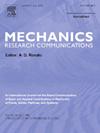Size effects in hexagonal and Re-entrant metamaterial beams under bending
IF 2.3
4区 工程技术
Q3 MECHANICS
引用次数: 0
Abstract
This paper investigates the effects of boundary conditions, cell topology, relative density, and functionally graded pattern on the size effects of metamaterial beams with a hexagonal unit cell subjected to concentrated transverse bending loads. Beams with clamped and simply supported end conditions were studied. Two hexagonal unit cell topologies (regular hexagonal and re-entrant geometries) and two functionally graded approaches (transversally functionally graded and axially functionally graded patterns) are adopted to create various metamaterial beams with different configurations. Numerical finite element analysis (FEA) simulations and the Euler-Bernoulli (EB) beam model were used to estimate the bending responses of the different metamaterial beams.
The results indicate that metamaterial beams with hexagonal unit cells exhibit stiffness-softening size effects under bending. This means that the smaller the difference between the unit cell size and the overall beam size, the larger the apparent deflection of the beam. This size-dependent behaviour of the hexagonal metamaterial beam is well captured by a nonlocal strain-gradient model. The cell topology and functionally graded patterns displayed limited impact on the size effects, while the relative density significantly influenced the size effects. Metamaterial beams with high relative density exhibit weaker size effects than their low relative density counterparts.
弯曲作用下六边形和可重入超材料梁的尺寸效应
本文研究了边界条件、单元拓扑结构、相对密度和功能梯度模式对六边形单元单元梁在集中横向弯曲荷载作用下的尺寸效应的影响。研究了端部夹紧和端部简支的梁。采用两种六边形单元胞拓扑(正六边形和重入几何)和两种功能梯度方法(横向功能梯度和轴向功能梯度模式)来创建不同构型的各种超材料梁。采用数值有限元分析(FEA)和Euler-Bernoulli梁模型对不同超材料梁的弯曲响应进行了估计。结果表明,具有六边形单元胞的超材料梁在弯曲作用下表现出刚度-软化尺寸效应。这意味着单元格尺寸和整体梁尺寸之间的差异越小,梁的表观挠度就越大。非局部应变梯度模型很好地捕捉了六边形超材料梁的这种尺寸依赖性行为。细胞拓扑结构和功能梯度模式对尺寸效应的影响有限,而相对密度对尺寸效应有显著影响。高相对密度的超材料梁比低相对密度的超材料梁表现出更弱的尺寸效应。
本文章由计算机程序翻译,如有差异,请以英文原文为准。
求助全文
约1分钟内获得全文
求助全文
来源期刊
CiteScore
4.10
自引率
4.20%
发文量
114
审稿时长
9 months
期刊介绍:
Mechanics Research Communications publishes, as rapidly as possible, peer-reviewed manuscripts of high standards but restricted length. It aims to provide:
• a fast means of communication
• an exchange of ideas among workers in mechanics
• an effective method of bringing new results quickly to the public
• an informal vehicle for the discussion
• of ideas that may still be in the formative stages
The field of Mechanics will be understood to encompass the behavior of continua, fluids, solids, particles and their mixtures. Submissions must contain a strong, novel contribution to the field of mechanics, and ideally should be focused on current issues in the field involving theoretical, experimental and/or applied research, preferably within the broad expertise encompassed by the Board of Associate Editors. Deviations from these areas should be discussed in advance with the Editor-in-Chief.

 求助内容:
求助内容: 应助结果提醒方式:
应助结果提醒方式:


